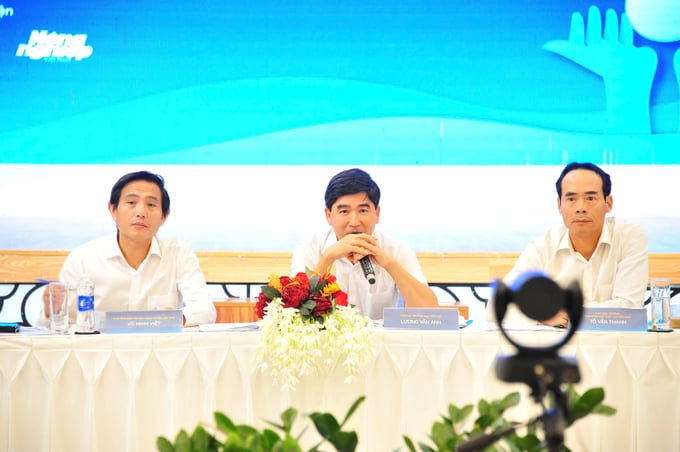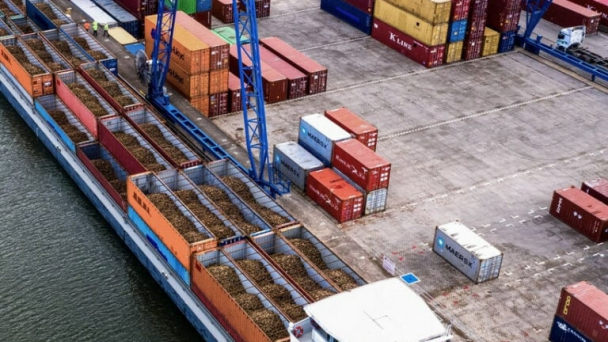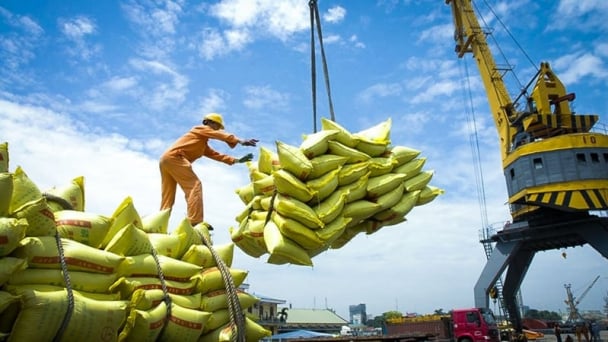May 30, 2025 | 01:02 GMT +7
May 30, 2025 | 01:02 GMT +7
Hotline: 0913.378.918
May 30, 2025 | 01:02 GMT +7
Hotline: 0913.378.918

Mr. Vu Minh Viet, Deputy Editor-in-Chief of VAN, Mr. Luong Van Anh, Deputy Director of the Department of Water Resources, Mr. To Van Thanh, Deputy Director of the Southern Institute of Water Resources Science host the forum.
On November 29, the forum "Strengthening Communication on Proper and Effective Water Use to Ensure Water Security in the Mekong Delta" convened experts, state management agencies, and enterprises to deliberate on strategies for conserving water resources through the construction of effective water works.
According to the Directorate of Water Resources, the Mekong Delta region obtains an annual water flow of approximately 475 billion cubic meters, with 95% of this flow originating from sources outside of Vietnam.
"The Mekong Delta is not devoid of water; however, during the dry season, two significant tidal surges result in severe salinity intrusion. Consequently, it is imperative to implement comprehensive solutions for water resource management. In order to achieve optimal efficiency, operational and exploitation measures must be synchronized and systemically implemented," stated Mr. Luong Van Anh, Deputy Director of the Department of Water Resources.
Mr. To Van Thanh, Deputy Director of the Southern Institute of Water Resources Science, stated that the Ministry of Agriculture and Rural Development is proposing projects and budgets for water resource exploitation and disaster prevention in the Mekong Delta during the 2026–2030 construction investment period. However, the implementation of the project is based upon the availability of resources and the certification of the project proposals by the state for future funding allocations.
The proposed plan is designed to address five critical issues in the Mekong Delta: erosion, flooding, drought, salinity intrusion, and land subsidence. Water storage and conservation for domestic use are among the proposed solutions, which have the potential to reduce groundwater extraction and mitigate subsidence.
Integrated solutions, such as the investment in protective infrastructure to accommodate the increasing sea levels, will also aid in the regeneration of mangrove forests for river and coastal protection. Furthermore, in order to guarantee sustainable economic development and agricultural production, it is imperative to make comprehensive investments in the region's three ecological zones: freshwater, brackish, and saline.

It is imperative to implement improved water resource management in the wake of the 2019–2020 drought and salinity crisis.
"In order to optimize efficiency, we must establish a multifunctional, multi-sectoral infrastructure at the same cost." Mr. To Van Thanh underscored the importance of this principle in the project's strategy.
The Southern Institute of Water Resources Science observed that the completion timelines of ongoing projects are uncertain, despite the fact that they require substantial financing. This pertains to river mouth investments. Pumping stations in Ca Mau and Kien Giang have been assigned specific responsibilities, including the management of drainage during periods of intense rainfall or high tides. Mr. To Van Thanh underscored the necessity of these engineering solutions in order to satisfy practical needs.
Mr. Vu Minh Thien provided a detailed explanation of the irrigation planning for 13 systems, which includes exhaustive systems such as Cai Lon – Cai Be and Long Xuyen, as well as enclosed systems like Go Cong and Go Dinh. Irrigation systems must be adequately supplied in order to manage 1.98 million hectares. High technical standards are also necessary for water transfer solutions between surplus and deficit locations.
Water scarcity persists in regions such as southern Ca Mau, which are analogous to coastal regions in Soc Trang and Bac Lieu. Consequently, the utilization of irrigation systems, including sluices along the Hau River and Xa No Canal, can assist in the prevention of salinity and the provision of water when required. Water can be directed to the Doc River to supply tens of thousands of hectares in southern Ca Mau if required.
A significant issue is the potential for high costs to be associated with solutions that aim to increase dry-season flow and decrease flood-season flow. The reverse fluxes into the lake are substantially reduced as a result of the reduced flood-season flow upstream, as seen in Tonle Sap Lake. This results in a reduction in dry-season outflows. It is imperative to conduct thorough evaluations of these effects.
Mr. Dinh Thanh Mung, Deputy Head of the Water Security Division, emphasized that water scarcity in the Mekong Delta is frequently less attentive from the perspective of agriculture. It is imperative to implement improved water resource management in the wake of the 2019–2020 drought and salinity crisis. Despite their significance to both the region and the nation, fruit trees in the delta are highly susceptible to water shortages, resulting in delayed recuperation rates than other crops.
Mr. Dinh Thanh Mung underscored the urgency of water conservation. He also observed that the Ministry of Agriculture and Rural Development will offer guidance on water-saving practices and zoning to assist local authorities.
Mr. Luong Van Anh underscored the importance of Resolution 36 in promoting water security awareness when queried about funding. This encompasses the development of irrigation systems and the storage of rainwater during the rainy season for subsequent use during the arid season. Future investments will concentrate on technical measures, including the optimization of water distribution, the reallocation of water from abundant areas to deficit regions, and the lowering of water intake gates. The objective of these endeavors is to guarantee sustainable water security for economic development, production, and human consumption.
Additionally, a comprehensive communication strategy will be implemented to incorporate water security content, foster community engagement, and increase awareness of the importance of safeguarding and utilizing this essential resource effectively.

(VAN) The mutual export of agrifood products between the European Union (EU) and the United Kingdom (UK) must occur again without certification, border controls or other red tape. This was agreed at the UK-EU summit.
/2025/05/22/5121-2-173645_677.jpg)
(VAN) NBSAP Tracker identifies strengths and areas for improvement in the National Biodiversity Strategy, based on each region’s priorities and capacities.

(VAN) The draft amendment to the Circular on rice export trading stipulates a periodic reporting regime for rice exporting enterprises.

(VAN) Dong Thap farmers attained an average profit margin of 64% during the summer-autumn 2024 crop (first season), while An Giang and Kien Giang farmers followed with 56% and 54%, respectively.

(VAN) As a doctoral student doing research on renewable energy and electrification at Harvard University, the author shares his musings on electricity, nature, and countryside memories.

(VAN) The decree on Extended Producer Responsibility (EPR) ensures transparent management and disbursement of support funds, avoiding the creation of a “give-and-take” mechanism.

(VAN) Hue City rigorously enforces regulations regarding marine fishing and resource exploitation, with a particular emphasis on the monitoring of fishing vessels to prevent illegal, unreported, and unregulated (IUU) fishing.